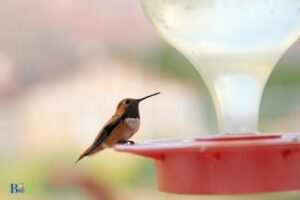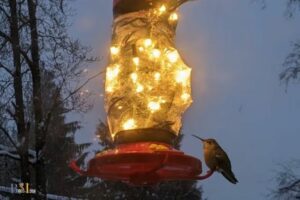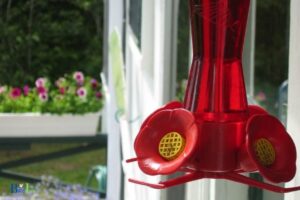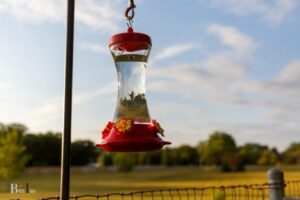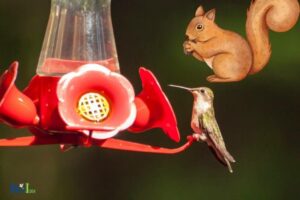How to Fill a Horizontal Hummingbird Feeder: Sugar Water!
To fill a horizontal hummingbird feeder, begin by cleaning the feeder, filling it with nectar or sugar water, and securely attaching the feeder ports and lid.
Horizontal hummingbird feeders are designed to lie flat, allowing birds to easily access the feeding ports. These feeders come in various styles and materials, but filling them follows the same basic process.
Ensuring the feeder is clean and filled with fresh nectar or sugar water will attract hummingbirds and keep them coming back.
Before filling a horizontal hummingbird feeder, make sure to clean it to remove any residue or contaminants. Mix a nectar solution by combining four parts water to one part granulated sugar, and bring it to a boil to dissolve the sugar.
Once cooled, use a funnel or pouring jug to fill the feeder with the nectar. Finally, ensure that all the feeding ports and lid are tightly fastened to prevent leaks, and hang your feeder in a shaded area for the hummingbirds to enjoy.
5 Steps to Fill a Horizontal Hummingbird Feeder:
| Step # | Task | Equipment Needed | Instructions |
| 1 | Preparation | Hummingbird feeder, nectar | Choose a horizontal hummingbird feeder and ensure it is clean and ready for use. |
| 2 | Make Nectar | Sugar, water, pot, stove | Mix 1 part sugar and 4 parts water and bring to a boil to dissolve the sugar. Allow the mixture to cool before using. |
| 3 | Fill the Feeder | Funnel, nectar | Use a funnel to pour the cool nectar into the horizontal feeder, filling it until it reaches the designated fill line. |
| 4 | Seal the Feeder | Feeder lid or stopper | Secure the lid or stopper on the feeder to prevent spills and ensure the nectar remains fresh. |
| 5 | Hanging the Feeder | Hook, outdoor location | Hang the feeder in a location that is easily accessible for hummingbirds and provide them with plenty of shade and resting areas nearby. |
Key Takeaway
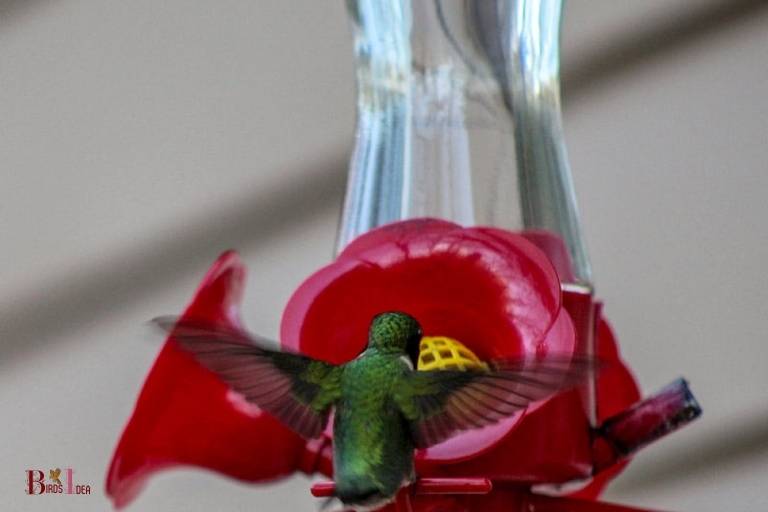
Five Facts About: Fill a Horizontal Hummingbird Feeder
What Is A Horizontal Hummingbird Feeder?
Definition Of A Horizontal Hummingbird Feeder
A horizontal hummingbird feeder is a flat-shaped vessel that has feeding ports mounted at the top or bottom, or both.
This type of feeder is designed with a shallow well-shaped basin that can hold nectar and allows hummingbirds to comfortably perch and feed.
Here are some key points to remember about a horizontal hummingbird feeder:
- It is used to attract and feed hummingbirds.
- It features a flat shape with feeding ports located at the top or bottom, or both.
- Its shallow well-shaped basin allows hummingbirds to perch while they feed.
Why Use A Horizontal Hummingbird Feeder?
Using a horizontal hummingbird feeder can be beneficial in many ways.
Here are some reasons why:
- It allows you to observe hummingbirds without disturbing them.
- Its flat shape ensures that hummingbirds have plenty of room to feed comfortably.
- It attracts more hummingbirds, as multiple birds can feed simultaneously.
- It reduces the frequency of refilling because of its larger capacity.
- It is easier to clean and maintain than other types of hummingbird feeders.
When using a horizontal hummingbird feeder, here are some tips to keep in mind:
- Keep the feeder clean and free from debris.
- Use fresh nectar daily and avoid using artificial sweeteners, honey, or syrup.
- Keep the feeder away from direct sunlight to prevent the nectar from spoiling.
- Hang the feeder in a shaded area to encourage more hummingbirds to visit.
Using a horizontal hummingbird feeder is an effective way to attract and feed hummingbirds. Its unique design provides several advantages, such as a larger capacity, ease of cleaning, and the ability to attract multiple birds at once.
By following these tips, you can enjoy regular visits from beautiful hummingbirds in your backyard.
List Of Required Tools And Materials
Hummingbirds are fascinating creatures with their unique ability to hover in midair and with their bright, vivid coloring. One way to attract these tiny birds is by providing them with a feeder filled with nectar.
In this blog post, we will discuss how to fill a horizontal hummingbird feeder and the necessary materials needed for the task.
Feeder
To fill a horizontal hummingbird feeder, you will require the following tools and materials:
- Hummingbird feeder: Make sure to select the horizontal hummingbird feeder that is suitable for your garden or balcony.
- Water: Use clean and cold water to fill your feeder. Hummingbirds prefer fresh water, so change it regularly.
- Hummingbird nectar: You can purchase hummingbird nectar from a store, or you can make it yourself by mixing four parts water with one part sugar.
- A dispenser: Use a funnel to pour the nectar into the dispenser to avoid spilling and wastage.
- A step-stool or ladder: If your feeder is at a height, you may need a step-stool or ladder to reach it safely.
Cleaning Supplies
It’s essential to keep your feeder clean to ensure that the hummingbirds remain healthy and avoid any infections.
Here are the cleaning supplies you’ll require:
- Hot water: Use hot water to rinse out the feeder and remove any remaining nectar.
- Mild detergent: Add a mild detergent to clean the feeder thoroughly.
- Brush: Use a small brush to scrub the inside and the feeding ports of the feeder.
- Towel: Dry the feeder completely after washing it thoroughly.
Hummingbird Guard
A hummingbird guard is a shield or dome that can be installed on top of the feeder to keep away rain and squirrels. It also helps to prevent the nectar from spoiling too quickly in the hot sun.
Ant Moats
Ants can often be a problem around hummingbird feeders since they are attracted to the nectar. To keep them away, use an ant moat that is a small container filled with water and placed between the feeder and its hanger.
The ants can’t swim, making it impossible for them to reach the feeder.
Mounting Bracket
A mounting bracket is required if you plan to hang the feeder from a hook or tree branch. Make sure that it is sturdy enough to hold the weight of the feeder.
Hummingbirds are incredible creatures, and it’s a joy to watch them feed from your backyard. By following these steps and using the necessary tools and materials, you can attract and feed these tiny birds.
Remember to clean your feeder regularly and keep it filled with fresh nectar to ensure that the hummingbirds remain healthy and happy.
Step 1: Preparation
Choose The Feeding Location
The first step to filling a horizontal hummingbird feeder is finding the perfect location to hang it.
Here are some tips to help you choose the ideal spot:
- Look for a shaded area: Direct sunlight can heat up the nectar and spoil it quickly. Find a location where the feeder will be shaded for most of the day.
- Keep it away from windows: Hummingbirds may accidentally fly into windows if the feeder is placed too close. Position it at least a few feet away from any windows to avoid this.
- Provide enough space: Make sure there is enough space for the hummingbirds to easily access the feeder, while keeping it out of reach of predators like cats.
Prepare Your Feeder
Before filling your feeder, here are some essential steps to prepare it:
- Clean it thoroughly: Ensure your hummingbird feeder is clean and free of mold, dirt, and debris. Use a mixture of hot water and vinegar to soak it before scrubbing it down and rinsing it off.
- Check for damages: Inspect your feeder for any cracks or damage that could cause it to leak or prevent hummingbirds from feeding.
- Fill it with fresh nectar: Only fill your feeder with fresh nectar. Avoid using red food dye, honey, or artificial sweeteners, as these can be harmful to hummingbirds.
By following these simple steps, you’ll be ready to fill your horizontal hummingbird feeder and attract these beautiful birds right to your backyard! Remember to regularly clean and refill your feeder to keep the hummingbirds happy and healthy.
Step 2: Mixing The Nectar
Mixing The Nectar
Now that you have obtained the best hummingbird feeder, it’s time to prepare the nectar for your feathered friends. Here are the essential steps to keep in mind when mixing the nectar for your horizontal hummingbird feeder.
Measuring The Sugar
Before starting, you need to have the necessary ingredients, including white granulated sugar and water.
Next, follow these steps to measure the right amount of sugar for your feeder:
- Use a measuring cup to measure four cups of water.
- Pour the water into a medium-sized saucepan and place it on a stovetop.
- Add one cup of white granulated sugar and stir to mix correctly.
Mixing The Nectar
Once you’ve measured the sugar, it’s time to mix it with the water.
Here are the steps to follow:
- Heat the mixture over medium heat and stir until the sugar dissolves. Avoid letting the mixture boil.
- Remove the sugar-water mixture from the stove and let it cool for ten minutes.
- Pour the mixture into the horizontal hummingbird feeder, filling it to the halfway point.
- Cover the lid and agitate the feeder gently until the nectar fully mixes.
Congratulations! You have correctly mixed the nectar for your horizontal hummingbird feeder. Remember to change it every few days, especially in hot or sunny weather, to prevent bacteria growth. Happy bird watching!
Step 3: Filling The Feeder
Hummingbirds are fascinating creatures that bring life and beauty to any garden. To attract these delicate birds, a hummingbird feeder is a must-have accessory.
However, filling the feeder can be a tricky task, especially if it is horizontal. Don’t worry; we’ve got you covered.
Here’s a step-by-step guide on how to fill a horizontal hummingbird feeder like a pro.
Unhook The Feeder From The Hanger
To start filling your hummingbird feeder, you need to take it down.
Here’s how you can do it:
- Gently unhook the feeder from its hanger without spilling the nectar inside.
- Make sure to hold the feeder steady while unhooking it to avoid any sudden movement that can cause the nectar to spill over.
Remove The Lid
Once the feeder is unhinged, it’s time to remove the lid. It’s important to do it carefully to avoid any damage to the feeder or spilling the nectar.
5 Steps to Fill a Horizontal Hummingbird Feeder:
- Hold the feeder with one hand and twist the lid gently with the other to unlock it.
- Slowly remove the lid and place it on a clean and dry surface, making sure it’s within reach.
Pour The Nectar
It’s time to fill the feeder with sweet nectar that will attract hummingbirds.
Here’s how to do it:
- Take the nectar mixture that you prepared earlier and pour it carefully into the feeder’s opening.
- Fill the feeder to its recommended capacity, being careful not to overfill it.
- Make sure that you pour the nectar slowly and steadily, aiming it towards the center to prevent any overflow.
Filling a horizontal hummingbird feeder isn’t as complicated as it seems. By following these easy steps, you’ll be able to attract these beautiful creatures in no time. Happy hummingbird watching!
Step 4: Maintenance
Hummingbirds are fascinating creatures, and watching them feed is a rewarding experience. To ensure your horizontal hummingbird feeder remains in good condition and your feathered friends keep coming back, regular maintenance is essential.
We will discuss step four of how to fill a horizontal hummingbird feeder – maintenance.
Keep The Feeder Clean
Keeping your feeder clean is crucial for your hummingbirds’ health. Dirty feeders can harbor harmful bacteria or fungi, leading to infections or illness among the hummingbirds.
Here are some tips for keeping your feeder clean:
- Clean the feeder thoroughly before refilling. Use a small bottlebrush or a mixture of vinegar and water to clean the feeder’s nooks and crannies effectively.
- Rinse the feeder and its parts with warm water.
- Refill the feeder only when it’s completely dry; water droplets can create a breeding ground for bacteria, leading to mold growth.
- Regularly check the feeder for mold or mildew. If you spot any black spots or build-up, discard the contents and start afresh.
Replace The Nectar Regularly
Hummingbirds love fresh nectar, and replacing the nectar often can help attract more birds. The sweet smell of fresh nectar can be intoxicating for hummingbirds, so it’s essential to ensure it’s fresh.
Here are some tips to keep the nectar fresh:
- Change the nectar solution every three to four days in hot weather and every five to seven days in moderate temperatures.
- If the nectar looks cloudy or has black spots, discard it immediately; it’s a sign that bacteria or fungi have contaminated it.
- Rinse the feeder thoroughly before refilling with fresh nectar.
Protect From Ants And Other Predators
Ants are drawn to the sweet nectar, and they can quickly infest your feeder. Fortunately, many simple tricks can help deter them.
Here’s how:
- Use an ant moat or ant guard. These are small plastic devices that attach to the hanger or hook where you hang your feeder. Ants cannot cross the water-filled moat, so they won’t get to the nectar
- Hang the feeder at least ten feet away from tree branches, fences, or other surfaces that predators can climb on. This will make it more difficult for them to get to the feeder.
- If you notice that predators are still getting to the feeder, consider using a protective cage around the feeder.
Maintaining a horizontal hummingbird feeder is quite simple but essential. Follow these guidelines to keep the feeder clean, replace the nectar regularly, and protect against ants and other predators. With proper care, you can enjoy hummingbirds’ company for years to come.
Tip 1: Choosing The Right Location
Choosing The Right Location For Your Hummingbird Feeder
Hummingbirds are one of the most fascinating birds in the world, and they are a delight to watch. One of the best ways to attract these little wonders to your garden is by setting up a hummingbird feeder.
But, it’s essential to choose the right location for your feeder to make it more visible and accessible to the hummingbirds.
Here are a few tips to consider when finding the perfect spot for your horizontal hummingbird feeder:
Away From Direct Sunlight
Hummingbirds prefer to feed in the shade because direct sunlight can dry out the nectar much faster. Therefore, place your feeder in an area where there is partial shade to protect the nectar and keep it from spoiling.
This will also prevent the nectar from fermenting or developing bacteria, which can be harmful to the little birds.
- The feeder should be placed in a shaded area for protection from direct sunlight.
- A tree or a shaded area of your garden is an ideal spot for the feeder.
Near Flowers Or Bushes
Hummingbirds are attracted to flowers and plants, so it’s wise to position your feeder near them. This will make it easier for the birds to spot the feeder and will also give them a natural perch nearby.
Make sure to clean any waste or debris that might litter around the feeder to prevent it from attracting insects, such as ants or wasps.
- Place the feeder close to a flower garden or bushes for a more natural setting.
- Make sure to keep the area around the feeder clean and clear of any waste or debris.
Finding the right location for your horizontal hummingbird feeder is crucial. By placing the feeder in partial shade, near flowers or bushes, and in a clean area, you’ll attract more hummingbirds to your garden, and it will be a perfect setting for them to enjoy a refreshing drink.
Remember to refill the feeder regularly and keep it clean to avoid contaminating the nectar and to prevent ants or wasps from creeping in.
Tip 2: Preparing The Nectar
Hummingbirds are fascinating creatures that can bring your garden to life with their colorful appearance and energetic movements.
One of the best ways to attract them is by using a horizontal hummingbird feeder filled with nectar. However, many people struggle with filling their feeders effectively.
Boiling The Water
The first step to preparing the nectar is to boil water.
Here are the key points to keep in mind when boiling water for your hummingbird feeder:
- Fill a pot with the desired amount of water and place it on the stove over medium-high heat
- Wait for the water to come to a rolling boil
- Once the water is boiling, turn off the heat and let it cool to room temperature before adding sugar
Adding The Sugar
After boiling the water, it is time to add sugar.
Here are the key points to keep in mind when adding sugar to your hummingbird feeder:
- Use a 1: 4 ratio of sugar to water (1 cup of sugar per 4 cups of water)
- Add the desired amount of sugar to the cooled water
- Stir the mixture until the sugar is completely dissolved
- Pour the nectar into the feeder
By following these simple steps, you can ensure that you prepare the perfect nectar for your hummingbird feeder.
Keep in mind that it is crucial to clean your feeder regularly and replace the nectar every few days to prevent contamination and keep your feathered friends healthy.
Happy hummingbird watching!
Tip 3: Cleaning And Maintenance
Maintaining a clean and functional hummingbird feeder is crucial for the health and safety of our feathered friends. It ensures that the birds have access to fresh nectar while avoiding the dangers associated with mould and bacteria.
Here are some tips to help you keep your horizontal hummingbird feeder clean and safe for your little visitors.
Cleaning The Feeder
Regular cleaning of the feeder is essential to ensure that it is free from mould and bacteria, both of which can be harmful to hummingbirds.
Here are the steps to follow when cleaning your horizontal hummingbird feeder:
- Empty the remaining nectar from the feeder and rinse it with warm water.
- Use a small brush or sponge and mild soap to wash the feeder thoroughly, making sure to scrub all the nooks and crannies.
- Rinse the feeder thoroughly with warm water, making sure all soap residue is removed.
- Allow the feeder to dry completely before refilling it with fresh nectar.
Handling Bees And Wasps
Bees and wasps can be a common issue with hummingbird feeders, but there are some ways to keep them away from the feeder.
Here are some tips to follow to keep bees and wasps away from your feeder:
- Avoid using yellow or red plastic feeders, as bees and wasps are attracted to these colors.
- Hang the feeder away from the hives or nests of bees and wasps.
- Use bee guards or wasp traps to keep these insects away from your feeder.
- Place sticky traps designed to capture bees and wasps near the feeder. These traps can be purchased at your local hardware store.
With these tips and tricks in mind, you can be sure that your horizontal hummingbird feeder stays clean and functional all year round. Your feathery friends will thank you for it!
FAQ On How To Fill A Horizontal Hummingbird Feeder
How Do You Fill A Horizontal Hummingbird Feeder?
How Often Should You Refill A Hummingbird Feeder?
What Is The Best Time Of Day To Fill A Hummingbird Feeder?
How Do You Keep Ants And Bees Away From The Feeder?
Conclusion
Filling a horizontal hummingbird feeder can be an enjoyable experience for bird enthusiasts. By providing these tiny birds with sugar water filled feeders, you are contributing positively towards their welfare and migration.
The best time to refill the feeder is when it’s half-empty, to ensure fresh sugar water at all times, and avoid accidental spillage.
It’s important to choose the right type of feeder according to the area it’s placed in and ensure it’s securely attached to avoid accidents.
Adequate cleaning of the feeder needs to be carried out every few days to prevent the growth of mold and bacteria.
The use of a brush and soap solution will help in cleansing the feeder properly.
By following these tips, you can enjoy the company of hummingbirds in your backyard and also contribute towards their natural feeding needs. Cheers to happy bird-watching and conservation!

